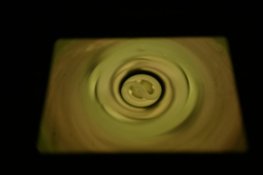I decided to run a bit of an experiment. Now, the CFL thread is moldering in the Soapbox, so if you want to rant about CFL's, and the incandescent ban, go there.
This is just about trying to get one to work in an enlarger.
My Besseler 5x7 diffusion enlarger takes edison type bulbs, so I decided to try out a a biggish spiral CFL in it, as I don't have a regular bulb for it yet.
The results of my hillbilly experiment are as follows:
As long as the lamp was warm, on/off cycles were predictable and consistent. If it cooled for more than a minute or so, I had to run it back up to temp to get it consistent again. A huge PIA, but sort of functional (kind of.. maybe).
The first image shows the projection with out the diffuser, focus set to the lamp. Now, nobody would expect this to be pretty, but it reveals an unexpected problem, at least with this particular lamp housing. You can see the lamp and housing, as expected, but the interesting part is that the spirals of the bulb, probably because of self masking in the spiral, and reflection/refraction angle, separate the green spike of the discontinuous spectral output, creating a neato (unless your trying to print with it) green hurricane looking thing. This is what the diffuser "sees" before it goes to work.
The second image is with the diffuser in place, but still focused on the lamp house, the green hurricane is diffused, but still readily visible. The fall off is a result of having the focus up in the lamp house.
With the focus set for projecting a negative to about 8x10, the light evens out (of course), and the camera couldn't pick it up, but I can still see green mottling with my eyes. With an incandesant, the smooth surface of the bulb is of course going to be more even, but with the spiral CFL, differing amounts of green here and there on the diffuser is death to contrast control on VC.
Conclusion- as of now, no go diggy di. I'll try some mods, if I think of any. My first idea would be to go get one with the plasic bulb looking envelope around it, but they are of much lower output. It is possible that the output spectrum will make up for that, except I'll go blind trying to grain focus.... More to follow.
This is just about trying to get one to work in an enlarger.
My Besseler 5x7 diffusion enlarger takes edison type bulbs, so I decided to try out a a biggish spiral CFL in it, as I don't have a regular bulb for it yet.
The results of my hillbilly experiment are as follows:
As long as the lamp was warm, on/off cycles were predictable and consistent. If it cooled for more than a minute or so, I had to run it back up to temp to get it consistent again. A huge PIA, but sort of functional (kind of.. maybe).
The first image shows the projection with out the diffuser, focus set to the lamp. Now, nobody would expect this to be pretty, but it reveals an unexpected problem, at least with this particular lamp housing. You can see the lamp and housing, as expected, but the interesting part is that the spirals of the bulb, probably because of self masking in the spiral, and reflection/refraction angle, separate the green spike of the discontinuous spectral output, creating a neato (unless your trying to print with it) green hurricane looking thing. This is what the diffuser "sees" before it goes to work.
The second image is with the diffuser in place, but still focused on the lamp house, the green hurricane is diffused, but still readily visible. The fall off is a result of having the focus up in the lamp house.
With the focus set for projecting a negative to about 8x10, the light evens out (of course), and the camera couldn't pick it up, but I can still see green mottling with my eyes. With an incandesant, the smooth surface of the bulb is of course going to be more even, but with the spiral CFL, differing amounts of green here and there on the diffuser is death to contrast control on VC.
Conclusion- as of now, no go diggy di. I'll try some mods, if I think of any. My first idea would be to go get one with the plasic bulb looking envelope around it, but they are of much lower output. It is possible that the output spectrum will make up for that, except I'll go blind trying to grain focus.... More to follow.
Attachments
Last edited by a moderator:













